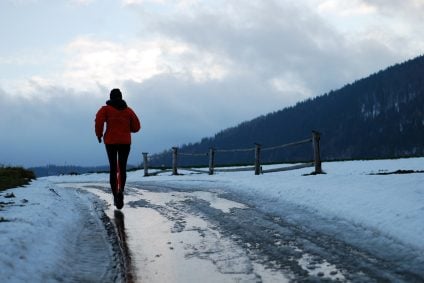Winter running 101
Don’t hang up your running shoes once the snow starts to fall. Here’s the info you need to keep going all year round

Who says winter has to be about cocooning at the gym (or worse yet, under the covers!)? If you love being outdoors, there’s no reason why you can’t take your cardio on the road, sidewalk or trail‘even when the mercury drops below zero.
Winter running can be addictive, says Bryan Smith, Toronto-area manager of Running Room Canada. ‘I love the opportunity to breathe fresher air than any other time of the year. When there’s snow on the ground, I love to make the first footprints, and that crunch under my shoes,’ rhapsodizes the 9-year veteran of winter running.
Also, says Smith, ‘I like being one of ‘those crazy people’ drivers see running in the winter. It’s fun to know I might be inspiring someone to try it ‘ because I used to be on the giving side of that comment!’
Think you want to try being one ‘those crazy people,’ too? Read on for our tips.
The benefits of winter running
Running torches through 270 to 500-plus calories per half-hour session (your personal results will vary based on your body weight, pace and environmental conditions), making it an excellent weight-bearing cardio sport. Weight-bearing activities are especially important for women since they help protect against osteoporosis.
Whether you run in the warm or cold doesn’t make a huge difference, says Dr. Stuart Phillips, a professor of kinesiology at Hamilton Ont.’s McMaster University, although he says, winter running may have a slight advantage: ‘You may have to work a little harder to stay warm.’
The gear you need
Gearing up for winter running means preparing for the cold, as well as slippery conditions.
‘ Clothes
Think: comfort and versatility. But for best results, says Smith: ‘You want to start your run almost uncomfortably cool; you’ll be warm within 10 minutes.’
‘Everything should be technical or sport natural fibres like merino wool or silk blended with synthetics, ‘ says Smith.
Base layer: ‘Wear the closest-fitting, thinnest fabric against your skin and add more garments on top based on your tolerance to the cold,’ says Smith.
Layer two: ‘Fleeces make great insulator layers but don’t block the wind well,’ says Smith, meaning you’ll most likely need a top layer, unless you choose wind-resistant fleece.
Layer three: A breathable shell or windbreaker. ‘Your top layer should block the wind and precipitation,’ says Smith.
Want to travel light? ‘If you want to wear as few layers as possible, consider compression garments for your base layer as these tend to keep you quite warm,’ advises Smith.
Ultimately, be prepared for trial and error. And don’t think it’s nerdy to log the weather conditions and what you wore. After all, you want to remember the perfect combo as well as what to avoid, when. ‘Ideally, you don’t want to be sweaty on a winter run, nor chilly for more than the first 10 minutes,’ says Smith.
‘ Shoes
Feel free to use the same shoes year-round: most winter runners do. Or consider all-season or winter runners with water-resistant uppers and deeper treads.
Trail-running shoes are also popular. Finally, some runners use strap-on ‘grippers’ with metal coils or spikes to increase traction in tricky conditions.
Pair your shoes with technical socks designed for winter, so you get maximum warmth without ruining the fit of your shoes with bulky, extra-thick socks.
‘ Accessories
Don’t forget your hat, gloves/mitts and neck gaiter (not scarf). Again, look for technical fabrics that add warmth without bulk, and that effectively wick away sweat.
Winter running safety
As always, simple precautions will help ensure your safety.
‘ Got asthma? ‘Asthmatics are at greater risk for an attack when it’s cold and dry, so be prepared,’ says McMaster University’s Phillips. Stay on top of your regular asthma-control regimen, and pack your relief puffer just in case.
‘ Don’t start cold. ‘Warm up in the warmth,’ says Phillips. Go up and down the stairs or jump rope at an easy pace for a few minutes indoors to get your blood flowing and limber up before you head out.
‘ Give drivers a head’s up. ‘Wear more reflective clothing so you’re visible to drivers, and carry a whistle,’ says Smith.
‘ ‘Run with a buddy,’ advises Smith. This provides extra motivation as well as safety.
‘ Finally, be prepared for contingencies: ‘Carry identification and public-transit fare, and let someone know your route and expected time of return,’ says Smith.
Don’t miss out! Sign up for our free weekly newsletters and get nutritious recipes, healthy weight-loss tips, easy ways to stay in shape and all the health news you need, delivered straight to your inbox.




